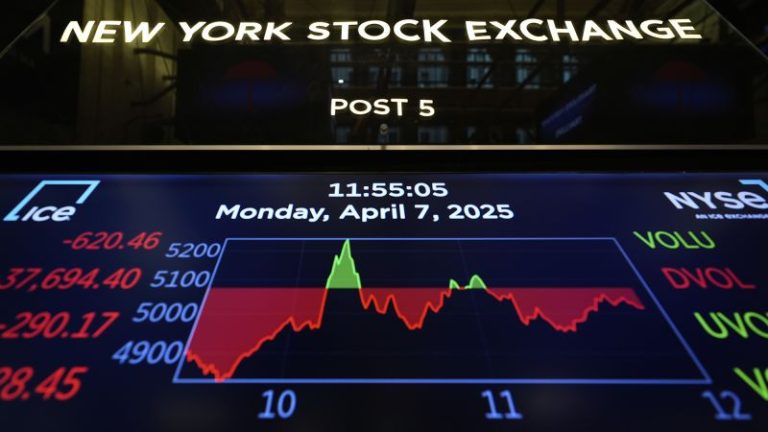The Perils of Unverified Information: How an Errant X Post Rocked the Stock Market
The stock market, a barometer of economic sentiment and a reflection of global financial health, is increasingly vulnerable to the rapid dissemination of information, both accurate and inaccurate, in the digital age. A recent incident involving a false post on X, formerly known as Twitter, vividly illustrates the power and peril of social media’s influence on financial markets. This incident, which triggered noticeable market fluctuations, underscores the critical need for reliable information and the potential consequences of unchecked online narratives.
On a seemingly ordinary Monday morning, unsubstantiated "headlines" claiming a potential "90-day pause" in tariffs imposed by the Trump administration began circulating on X. This rumor, devoid of any credible source, ignited a flurry of activity on trading floors as investors, ever sensitive to policy shifts, reacted swiftly to the prospect of a reprieve from trade tensions. The market responded with an immediate surge, driven by the hope that the rumored tariff pause would alleviate economic pressures. However, the jubilation was short-lived. The White House promptly refuted the rumor, exposing the circulating information as false and plunging the market back into uncertainty.
The origins of the false post can be traced back to a Fox News interview with National Economic Council Director Kevin Hassett. While Hassett addressed the possibility of a tariff pause, his response was carefully noncommittal. However, an X account with a small following, "Hammer Capital," misinterpreted and misrepresented Hassett’s statements, creating the false headline that spurred the market reaction. This initial post, though originating from an account with limited reach, gained rapid traction when it was reposted by "Walter Bloomberg," an account with a significantly larger following. The use of a siren emoji further amplified the sense of urgency and importance, contributing to the rapid spread of the misinformation.
The impact of the false post was swift and significant. Within minutes of its appearance on X, cheers erupted on the floor of the New York Stock Exchange as stock indices, already recovering from earlier dips, experienced a sudden surge. The rapid dissemination of the false headline through social media channels caught major news outlets off guard. CNBC, a prominent financial news network, initially reported the rumor, attributing it to Hassett, before realizing its lack of verification. The network’s on-air discussion reflected the confusion and scramble to source the information, demonstrating the challenges of navigating the real-time information flow of the digital age. Even Reuters, a respected international news agency, briefly reported the rumor, citing CNBC, before issuing a retraction and acknowledging its error.
The incident exposed several vulnerabilities in the current information ecosystem. Firstly, it highlighted the susceptibility of financial markets to unverified information circulating on social media. The rapid and often automated nature of information sharing on platforms like X allows rumors and misinformation to spread quickly, impacting market sentiment before accurate information can be disseminated. Secondly, the episode underscored the challenges faced by even established news organizations in verifying information in real-time. The pressure to report breaking news quickly can sometimes lead to the dissemination of unverified information, particularly when amplified by influential social media accounts.
The "Walter Bloomberg" account, which played a key role in amplifying the false information, exemplifies the potential for misleading online personas. By adopting a name similar to the Bloomberg financial news service, the account seemingly leveraged the credibility of an established institution to gain trust and followers. The incident also exposed the limitations of verification systems on social media platforms. Both "Walter Bloomberg" and "Hammer Capital" possessed blue checkmarks on X, which, prior to Elon Musk’s acquisition of the platform, signified verified identities. However, the subsequent shift to a paid verification system has eroded the meaning of the blue checkmark, making it difficult to discern authentic accounts from those seeking to exploit the system for influence or malicious purposes.
Finally, the incident highlighted the crucial need for responsible social media usage and the importance of verifying information before sharing it. While "Hammer Capital" claimed to be merely "regurgitating" information circulating on trading desks, their actions demonstrate the potential consequences of amplifying unverified claims. The subsequent deletion of the post by "Walter Bloomberg" and the attempts by both accounts to shift blame onto other sources underscore the lack of accountability often observed in the online sphere. This incident serves as a cautionary tale, emphasizing the importance of critical thinking and the verification of information from reliable sources, especially in the context of sensitive domains like financial markets. It also underscores the responsibility of social media platforms to implement effective measures to combat the spread of misinformation and to hold users accountable for the information they disseminate.


